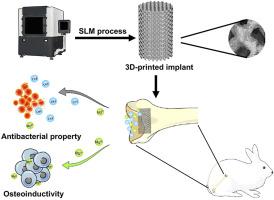Bioactive Materials ( IF 18.9 ) Pub Date : 2021-07-06 , DOI: 10.1016/j.bioactmat.2021.06.032 Kai Xie 1 , Nanqing Wang 2 , Yu Guo 3 , Shuang Zhao 1 , Jia Tan 1 , Lei Wang 1 , Guoyuan Li 4 , Junxiang Wu 1 , Yangzi Yang 1 , Wenyu Xu 2 , Juan Chen 2 , Wenbo Jiang 5 , Penghuai Fu 2 , Yongqiang Hao 1, 5

|
Magnesium (Mg) alloys that have both antibacterial and osteogenic properties are suitable candidates for orthopedic implants. However, the fabrication of ideal Mg implants suitable for bone repair remains challenging because it requires implants with interconnected pore structures and personalized geometric shapes. In this study, we fabricated a porous 3D-printed Mg-Nd-Zn-Zr (denoted as JDBM) implant with suitable mechanical properties using selective laser melting technology. The 3D-printed JDBM implant exhibited cytocompatibility in MC3T3-E1 and RAW267.4 cells and excellent osteoinductivity in vitro. Furthermore, the implant demonstrated excellent antibacterial ratios of 90.0% and 92.1% for methicillin-resistant S. aureus (MRSA) and Escherichia coli, respectively. The 3D-printed JDBM implant prevented MRSA-induced implant-related infection in a rabbit model and showed good in vivo biocompatibility based on the results of histological evaluation, blood tests, and Mg2+ deposition detection. In addition, enhanced inflammatory response and TNF-α secretion were observed at the bone-implant interface of the 3D-printed JDBM implants during the early implantation stage. The high Mg2+ environment produced by the degradation of 3D-printed JDBM implants could promote M1 phenotype of macrophages (Tnf, iNOS, Ccl3, Ccl4, Ccl5, Cxcl10, and Cxcl2), and enhance the phagocytic ability of macrophages. The enhanced immunoregulatory effect generated by relatively fast Mg2+ release and implant degradation during the early implantation stage is a potential antibacterial mechanism of Mg-based implant. Our findings indicate that 3D-printed porous JDBM implants, having both antibacterial property and osteoinductivity, hold potential for future orthopedic applications.
中文翻译:

用于消除植入物相关感染的增材制造的可生物降解多孔镁植入物:一项体外和体内研究
具有抗菌和成骨特性的镁 (Mg) 合金是骨科植入物的合适候选材料。然而,适合骨修复的理想镁植入物的制造仍然具有挑战性,因为它需要具有互连孔结构和个性化几何形状的植入物。在这项研究中,我们使用选择性激光熔化技术制造了具有合适机械性能的多孔 3D 打印 Mg-Nd-Zn-Zr(表示为 JDBM)植入物。3D 打印的 JDBM 植入物在 MC3T3-E1 和 RAW267.4 细胞中表现出细胞相容性,并在体外具有出色的骨诱导性。此外,该植入物对耐甲氧西林金黄色葡萄球菌(MRSA) 和大肠杆菌的抗菌率分别为 90.0% 和 92.1%, 分别。根据组织学评估、血液测试和 Mg 2+沉积检测的结果,3D 打印的 JDBM 植入物在兔模型中预防了 MRSA 诱导的植入物相关感染,并显示出良好的体内生物相容性。此外,在早期植入阶段,在 3D 打印 JDBM 植入物的骨-植入物界面处观察到增强的炎症反应和 TNF-α 分泌。3D 打印的 JDBM 植入物降解产生的高 Mg 2+环境可以促进巨噬细胞的 M1 表型(Tnf、iNOS、Ccl3、Ccl4、Ccl5、Cxcl10 和 Cxcl2),并增强巨噬细胞的吞噬能力。相对较快的 Mg 2+产生的增强的免疫调节作用植入早期的释放和植入物降解是镁基植入物的潜在抗菌机制。我们的研究结果表明,具有抗菌性能和骨诱导性的 3D 打印多孔 JDBM 植入物具有未来骨科应用的潜力。



























 京公网安备 11010802027423号
京公网安备 11010802027423号